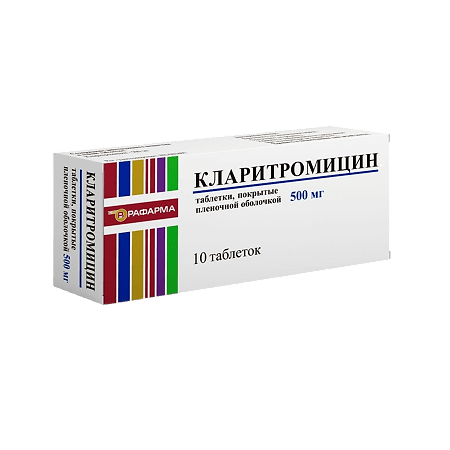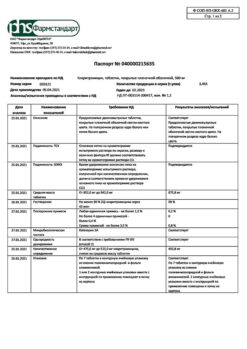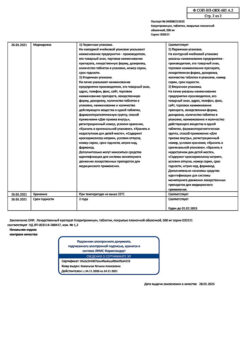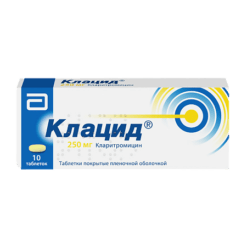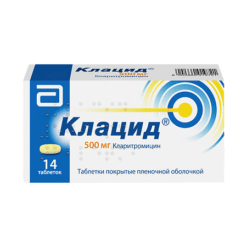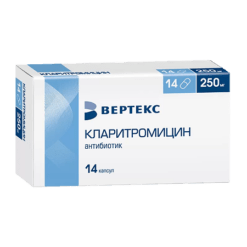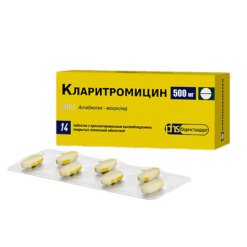No products in the cart.
Clarithromycin, 500 mg 10 pcs
€10.47 €8.41
Description
Pharmacotherapeutic group: antibiotic-macrolide.
Code ATX: J01FA09
Pharmacological properties
Pharmacodynamics
. Clarithromycin is a semisynthetic antibiotic of the macrolide group and has an antibacterial effect by interacting with the 50S ribosomal subunit and inhibiting the protein synthesis of bacteria susceptible to it.
Clarithromycin has shown high in vitro activity against both standard laboratory strains of bacteria and those isolated from patients in clinical practice. It shows high activity against many aerobic and anaerobic gram-positive and gram-negative microorganisms. Minimum inhibitory concentrations (MIC) of clarithromycin for most pathogens are lower than MIC of erythromycin on average by one log2 dilution.
Clarithromycin in vitro is highly active against Legionella pneumophila, Mycoplasma pneumoniae. It has a bactericidal effect against Helicobacter pylori, this activity of clarithromycin is higher at neutral pH than at acidic pH.
In addition, in vitro and in vivo data indicate that clarithromycin is active against clinically relevant mycobacterial species. Enterobacteriaceae and Pseudomonas spp. also other non-lactose-fermenting Gram-negative bacteria are not sensitive to clarithromycin.
The activity of clarithromycin against most strains of the following microorganisms has been proven both in vitro and in clinical practice for the diseases listed under “Indications for use”.
Aerobic Gram-positive microorganisms: Staphylococcus aureus, Streptococcus pneumoniae, Streptococcus pyogenes, Listeria monocytogenes.
Aerobic Gram-negative microorganisms: Haemophilus influenzae, Haemophilus parainfluenzae, Moraxella catarrhalis, Neisseria gonorrhoeae, Legionella pneumophila.
Other microorganisms: Mycoplasma pneumoniae, Chlamydia pneumoniae (TWAR). Mycobacteria: Mycobacterium leprae, Mycobacterium kansasii, Mycobacterium chelonae, Mycobacterium fortuitum, Mycobacterium avium complex (MAC) – complex including: Mycobacterium avium, Mycobacterium intracellulare.
The production of beta-lactamase has no effect on clarithromycin activity. Most staphylococcal strains resistant to methicillin and oxacillin are also resistant to clarithromycin.
Helicobacter pylori
The sensitivity of H.pylori to clarithromycin was studied on isolates of H. pylori isolated from 104 patients before starting therapy with the drug. Clarithromycin-resistant H.pylori strains were isolated in 4 patients, 2 patients had moderate resistance strains, and the remaining 98 patients had clarithromycin-sensitive H.pylori isolates.
Clarithromycin has in vitro action against most strains of the following microorganisms (but the safety and effectiveness of clarithromycin in clinical practice has not been confirmed by clinical studies, and the practical value remains unclear):
- aerobic gram-positive microorganisms: Streptococcus agalactiae, Streptococci
(groups C, F, G)., Viridans group streptococci;
- aerobic gram-negative microorganisms: Bordetella pertussis, Pasteurella
- anaerobic gram-positive microorganisms: Clostridium perfringens, Peptococcus niger, Propionibacterium acnes;
- anaerobic gram-negative microorganisms: Bacteroides melaninogenicus;
- Spirochetes: Borrelia burgdorferi, Treponema pallidum;
- Campylobacter: Campylobacter
The main metabolite of clarithromycin in humans is the microbiologically active metabolite 14-hydroxyclarithromycin (14-OH-clarithromycin). The microbiological activity of the metabolite is the same as that of the parent substance, or 1-2 times weaker against most microorganisms. The exception is H. influenzae, against which the effectiveness of the metabolite is twice as high. The parent substance and its main metabolite have either additive or synergistic effect against H.influenzae under conditions in vitro and in vivo depending on the bacterial strain.
Sensitivity test
Quantitative methods, which require measuring the diameter of the growth suppression zone, provide the most accurate estimates of the sensitivity of bacteria to antimicrobial agents. One recommended technique for sensitivity testing uses discs impregnated with 15 µg of clarithromycin (Kirby-Bauer disc-diffusion method); the diameters of the growth-suppression zones correlate with the IPC values of clarithromycin when interpreting the test. IPC values are determined by dilution in broth or agar.
When using these techniques, a report from the laboratory that the strain is “sensitive” indicates that the infectious agent is likely to respond to treatment. A “resistant” response indicates that the pathogen will probably not respond to treatment. A response of “intermediate sensitivity” suggests that the therapeutic effect of the drug may be ambiguous, or the microorganism may be sensitive using higher doses of the drug (intermediate sensitivity is also called “moderate sensitivity”).
Pharmacokinetics
absorption
The drug is easily and quickly absorbed in the gastrointestinal tract. Absolute bioavailability is about 50%. No cumulation was found when multiple doses of the drug were administered, and the metabolic pattern in the human body was not altered. Eating immediately before taking the drug increased the bioavailability of the drug by 25% on average. Overall, this increase is insignificant and should have little clinical significance with the recommended dosing regimens. Therefore, clarithromycin can be used regardless of food intake.
Distribution, metabolism and excretion In vitro
The in vitro studies showed that clarithromycin binds to plasma proteins by 70% at concentrations ranging from 0.45 to 4.5 µg/mL. At a concentration of 45.0 µg/ml, the binding decreases to 41%, probably as a result of saturation of the binding sites. This is observed only at concentrations many times greater than the therapeutic concentration.
In vivo
in vivo animal studies have shown that clarithromycin is present in all tissues except the central nervous system at concentrations several times greater than plasma. The highest concentrations (10-20 times higher than plasma concentrations) were found in the liver and lungs.
Health
. When clarithromycin was administered at a dose of 250 mg 2 times daily, the maximum equilibrium concentration (Cmax) of clarithromycin and 14-OH-clarithromycin in plasma was reached after 2-3 days and was 1 µg/mL and 0.6 µg/mL, respectively. The half-life (T1/2) of clarithromycin and its main metabolite was 3-4 hours and 5-6 hours, respectively.
When clarithromycin was administered at a dose of 500 mg twice daily, the Cmax of clarithromycin and 14-OH-clarithromycin in plasma was reached after the 5th dose. After the 5th and 7th dose, the Cmax of clarithromycin and 14-OH-clarithromycin in plasma averaged 2.7-2.9 mcg/mL and 0.88-0.83 mcg/mL, respectively. The T1/2 of clarithromycin and its main metabolite was 4.5-4.8 hours and 6.9-8.7 hours, respectively.
The cmax of 14-OH clarithromycin did not increase in proportion to the clarithromycin dose, whereas the T1/2 of both clarithromycin and its hydroxylated metabolite tended to increase with increasing dose.
This nonlinear pharmacokinetics of clarithromycin combined with decreased formation of 14-hydroxylated and N-demethylated products at high doses indicates a nonlinear metabolism of clarithromycin that becomes more pronounced at higher doses.
The kidneys excreted about 37.9% after oral clarithromycin doses of 250 mg and 46.0% after clarithromycin doses of 1200 mg; the intestines excreted about 40.2% and 29.1% (including subjects with only one stool sample containing 14.1%), respectively.
Patients
Clarithromycin and its metabolite 14-OH-clarithromycin penetrate rapidly into tissues and body fluids. There is limited evidence that the concentration of clarithromycin in cerebrospinal fluid during oral administration is negligible (i.e., only 1-2% of the serum concentration with normal blood-brain barrier permeability). Concentrations in tissues are usually several times higher than in blood serum.
The table gives examples of tissue and serum concentrations:
Concentrations (250 mg every 12 hours) | |||
Tissue type | Tissue (µg/g) | Serum (µg/mL) | |
My tonsils | 1.6 | 0.8 | |
Light | 8.8 | 1.7 | |
LiverLiver function disorders
In patients with moderate to severe hepatic impairment but with preserved renal function, clarithromycin dose adjustment is not necessary. Equilibrium plasma concentration and systemic clearance of clarithromycin do not differ between patients in this group and healthy patients. Equilibrium concentration of 14-OH clarithromycin is lower in people with hepatic impairment than in healthy subjects. Kidney dysfunction
In impaired renal function, the Cmax and minimum concentration (Cmin) of clarithromycin in plasma, the elimination half-life and the area under the pharmacokinetic concentration-time curve (AUC) of clarithromycin and its metabolite 14-OH-clarithromycin increase. The elimination constant and renal excretion decreases. The degree of change in these parameters depends on the degree of renal impairment.
Elderly patients
Elderly patients had higher blood concentrations of clarithromycin and its metabolite 14-OH-clarithromycin and slower excretion than the younger group. However, after adjustment for renal creatinine clearance, there were no differences in the two groups. Thus, the main influence on the pharmacokinetic parameters of clarithromycin is renal function, not age.
Patients with mycobacterial infections
. Equilibrium concentrations of clarithromycin and 14-OH clarithromycin in patients with HIV infection who received clarithromycin at conventional doses (500 mg twice daily) were similar to those in healthy subjects. However, when clarithromycin is used in higher doses that may be necessary to treat mycobacterial infections, concentrations of the antibiotic may be significantly higher than usual. In HIV-infected patients taking clarithromycin at a dose of 1000 mg/day or 2000 mg/day in two doses, equilibrium Cmax values were typically 2-4 mcg/ml and 5-10 mcg/ml, respectively. When using the drug in higher doses, a prolongation of the T1/2 was observed compared to that in healthy subjects receiving clarithromycin in usual doses. The increased plasma concentrations and prolongation of the elimination half-life when using clarithromycin at higher doses are due to the non-linear pharmacokinetics of the drug.
Combined treatment with omeprazole
Clarithromycin 500 mg 3 times daily in combination with omeprazole at a dose of 40 mg/day helps to increase the T1/2 and AUC0-24 of omeprazole. There was an 89% increase in AUC0-24 and 34% increase in T1/2 of omeprazole in all patients receiving combination therapy compared to those receiving omeprazole alone. Clarithromycin had Cmax, Cmin, and AUC0-8 increases of 10%, 27%, and 15%, respectively, compared with data when clarithromycin alone was used without omeprazole. At equilibrium, clarithromycin concentrations in gastric mucosa were 25 times higher 6 h after administration in the group receiving the combination compared with those receiving clarithromycin alone. Clarithromycin concentrations in gastric tissue 6 hours after the 2-drug regimen were twice as high as in the clarithromycin alone group.
Indications
Indications
Infectious and inflammatory diseases caused by microorganisms sensitive to the drug:
– infections of the upper respiratory tract and ENT organs (pharyngitis sinusitis);
– lower respiratory tract infections (bronchitis out-of-hospital pneumonia);
– infections of the skin and soft tissues (such as folliculitis inflammation of the subcutaneous tissue mumps).
Active ingredient
Active ingredient
Composition
Composition
In one tablet:
The active ingredient: clarithromycin – 500.00 mg.
Auxiliary substances: Hypromellose (hydroxypropylmethylcellulose 6 cPs) – 13.57 mg, hypromellose (hydroxypropylmethylcellulose 100 cPs) – 266.48 mg, lactose monohydrate – 176.36 mg, colloidal silicon dioxide – 4.84 mg, magnesium stearate – 7.75 mg;
coating: Aquarius Preferred MSP BPZ14073 Yellow [hypromellose (hydroxypropyl methylcellulose 6 cPs) – 5.225 mg, copovidone – 3.990 mg, polydextrose – 2.660 mg, macrogol-3350 (polyethylene glycol-3350) – 1,805 mg, medium-chain triglycerides – 0.570 mg, titanium dioxide – 3.665 mg, quinoline yellow dye – 1.064 mg, iron oxide yellow dye – 0.019 mg, aluminum blue dye (FD&C Blue No. 1 Aluminum Lake (11-13%)) – 0.002 mg] – 19.00 mg.
How to take, the dosage
How to take, the dosage
For oral administration regardless of meals.
Adults and children over 12 years of age – 1 tablet (250 mg) 2 times a day.
In case of more severe infections, the dose is increased to 500 mg twice a day. Usual duration of treatment is from 5 to 14 days.
The exceptions are community-acquired pneumonia and sinusitis, which require 6 to 14 days of treatment.
Dosages for treatment of mycobacterial infections other than tuberculosis
The recommended dose for mycobacterial infections is clarithromycin 500 mg twice daily.
The treatment of disseminated MAC infections in patients with AIDS should be continued as long as there is clinical and microbiological efficacy. Clarithromycin should be administered in combination with other antimicrobials active against these pathogens. The duration of treatment of other non-tuberculous mycobacterial infections is determined by the physician.
For the prevention of infections caused by MAC
The recommended dose of clarithromycin for adults is 500 mg twice daily.
For odontogenic infections
The dose of clarithromycin is 250 mg (1 tablet) 2 times daily for 5 days.
For eradication of Helicobacter pylori
In patients with peptic ulcer disease caused by Helicobacter pylori infection, clarithromycin may be prescribed 500 mg twice daily in combination with other antimicrobials and proton pump inhibitors for 7-14 days, according to national and international guidelines for the treatment of Helicobacter pylori infection.
Patients with renal impairment
Patients with creatinine clearance less than 30 ml/min are prescribed half the usual dose of clarithromycin, i.e.i.e. 250 mg (1 tablet) once daily or, for more severe infections, 1 tablet (250 mg) 2 times daily. Treatment of such patients is continued for no more than 14 days.
Application in children younger than 12 years
The use of clarithromycin tablets in children younger than 12 years has not been studied.
Interaction
Interaction
Co-administration of clarithromycin increases the blood concentrations of drugs metabolized in the liver via cytochrome P450 isoenzymes (CYP3A), which can increase their concentrations and prolong or intensify both therapeutic and adverse effects.
The co-administration with such drugs as astemizole cisapride pimozide terfenadine ergotamine dihydroergotamine alprazolam midazolam triazolam (oral dosage forms) simvastatin lovastatin is contraindicated due to the possibility of serious side effects (see “Contraindications. “
Cyzapride and pimozide
Cyzapride and pimozide may be used together: increased concentration of cisapride increased QT interval occurrence of cardiac arrhythmias including ventricular tachycardia including pirouette-type ventricular fibrillation.
Terphenadine and astemizole
When used concomitantly, the following may occur: increased terphenadine/astemizole blood concentrations increased cardiac arrhythmias increased QT interval ventricular tachycardia ventricular fibrillation and pirouette tachycardia.
Ergotamine/dihydroergotamine
If used concomitantly, the following effects associated with acute poisoning with drugs of the ergotamine group are possible: vascular spasm, ischemia of the extremities and other tissues including the central nervous system.
The effect of other drugs on clarithromycin
Drugs that are CYP3A isoenzyme inducers (e.g., rifampicin phenytoin carbamazepine phenobarbital St. John’s wort) may induce metabolism of clarithromycin. This can lead to subtherapeutic concentrations of clarithromycin, resulting in reduced efficacy. In addition, it is necessary to monitor the plasma concentration of CYP3A isoenzyme inducer that may increase due to inhibition of CYP3A isoenzyme inducer by clarithromycin. When rifabutin and clarithromycin were used together, there was an increase in plasma concentrations and a decrease in serum concentrations of clarithromycin with an increased risk of uveitis.
The following drugs have proven or suspected effects on plasma concentrations of clarithromycin; doses may need to be adjusted or alternative treatment may be necessary if they are used with clarithromycin.
Efavirenz nevirapine rifampicin rifabutin and rifapentin
. Strong cytochrome P450 inducers such as efavirenz nevirapine rifampicin rifabutin and rifapentine can accelerate the metabolism of clarithromycin and thus decrease the plasma concentration of clarithromycin and weaken its therapeutic effect and simultaneously increase the concentration of 14-OH clarithromycin, a metabolite that is also microbiologically active. Since microbiological activity of clarithromycin and 14-OH clarithromycin differs in respect to different bacteria, the therapeutic effect may be reduced when clarithromycin and enzyme inducers are used together.
Ethravirin
The concentration of clarithromycin is decreased with etravirin but the concentration of the active metabolite 14-OH-clarithromycin is increased. Because 14-OH clarithromycin has low activity against Mycobacterium avium complex (MAC) infections, the overall activity against their pathogens may change so alternative treatments should be considered for MAC treatment.
Fluconazole
The co-administration of fluconazole at a dose of 200 mg daily and clarithromycin at a dose of 500 mg twice daily in 21 adult volunteers resulted in a 33% and 18% increase in the minimum mean equilibrium concentration (Css) and AUC of clarithromycin, respectively. However, co-administration had no significant effect on the mean equilibrium concentration of the active metabolite 14-OH clarithromycin. Dose adjustment of clarithromycin in case of concomitant administration of fluconazole is not required.
Ritonavir
The co-administration of ritonavir 600 mg/day and clarithromycin 1 g/day may decrease the metabolism of clarithromycin (increase Cmax by 31 % Cmin by 182 % and AUC by 77 %) complete inhibition of 14-hydroxyclarithromycin formation.
The wide therapeutic range does not require dosage reduction in patients with normal renal function.
In patients with renal impairment, it is reasonable to consider the following dose adjustments: If creatinine clearance is 30-60 mL/min, the clarithromycin dose should be reduced by 50%.
Ritonavir should not be coadministered with clarithromycin in doses greater than 1 g per day.
In patients with a CKR of less than 30 ml/min, the dose of clarithromycin should be reduced by 75% using the appropriate clarithromycin dosage form.
Peroral antidiabetic agents/insulin
The concomitant use of clarithromycin and oral antidiabetic agents and/or insulin may lead to severe hypoglycemia. Concomitant use of clarithromycin with some oral antidiabetic drugs such as nateglinide pioglitazone repaglinide rosiglitazone due to inhibition of CYP3A isoenzyme by clarithromycin may cause hypoglycemia. Close monitoring of blood glucose concentrations is recommended.
The effect of clarithromycin on other drugs
Antirhythmic drugs (quinidine and disopyramide)
Ventricular pirouette tachycardia may occur when combined with quinidine or disopyramide. If clarithromycin is concomitantly used with these drugs, electrocardiograms should be monitored regularly to detect prolongation of QT interval, and serum concentrations of these drugs should be monitored.
CYP3A4 interactions
The co-administration of clarithromycin, which is known to inhibit the CYP3A enzyme, and agents primarily metabolized by the CYP3A enzyme may be associated with a mutual increase in their concentrations that may potentiate or prolong both therapeutic and adverse effects.
Clarithromycin should be used with caution in patients receiving drugs that are substrates of CYP3A isoenzyme especially if these drugs have a narrow therapeutic range (e.g.: carbamazepine) and/or are extensively metabolized by this enzyme. If necessary, the dose of the drug taken together with clarithromycin should be adjusted. The serum concentrations of drugs primarily metabolized by CYP3A isoenzyme should also be monitored if possible.
The following drugs/classes are metabolized by the same CYP3A isoenzyme as clarithromycin e.g. alprazolam carbamazepine cilostazol ciclosporine disopyramide methylprednisolone midazolam omeprazole indirect anticoagulants (eg warfarin) quinidine rifabutin sildenafil tacrolimus triazolam and vinblastine. Other CYP3A agonists include the following drugs that are contraindicated for co-administration with clarithromycin: astemizole cisapride pimozide terfenadine lovastatin simvastatin and ergot alkaloids (see “Contraindications”). Drugs interacting in a similar manner through other isoenzymes within the cytochrome P450 system include phenytoin theophylline and valproic acid.
HMG-CoA reductase inhibitors
The co-administration of clarithromycin with lovastatin or simvastatin is contraindicated (see “Contraindications.
Co-administration of lovastatin or simvastatin is contraindicated (see section “Contraindications”) due to the fact that these statins are significantly metabolized by CYP3A4 and co-administration with clarithromycin increases their serum concentrations, resulting in increased risk of myopathy including rhabdomyolysis. Rare cases of rhabdomyolysis have been reported in patients taking these drugs together. If clarithromycin is required, lovastatin or simvastatin should be discontinued during therapy.
Clarithromycin should be used with caution when combined therapy with statins. If coadministration is necessary, it is recommended to take the lowest dose of statin. Statins that are not dependent on CYP3A isoenzyme metabolism (e.g.: fluvastatin) should be used.
Peroral anticoagulants
There is a risk of serious bleeding and significantly increased prothrombin time when clarithromycin and warfarin are used concomitantly. If patients receive clarithromycin and oral anticoagulants concomitantly, prothrombin time and MHO should be monitored closely.
Omeprazole
The co-administration of clarithromycin and omeprazole may increase equilibrium plasma concentrations of omeprazole (Cmax AUC0-24 T1/2 by 30% 89% and 34%, respectively).
Sildenafil tadalafil and vardenafil
Each of these phosphodiesterase inhibitors is metabolized at least in part with CYP3A. However, the CYP3A isoenzyme may be inhibited in the presence of clarithromycin. Co-administration of clarithromycin with sildenafil tadalafil or vardenafil may lead to increased inhibitory effects on phosphodiesterase. A reduction in the dose of sildenafil tadalafil and vardenafil should be considered when prescribing these drugs together.
Theophylline carbamazepine
Theophylline or carbamazepine may increase systemic blood flow concentrations.
Tolterodine
The primary metabolism of tolterodine is through the 2D6 isoform of cytochrome P450 (CYP2D6). However, in a portion of the population lacking the CYP2D6 isoenzyme, metabolism occurs via CYP3A. In this population, suppression of the CYP3A isoenzyme leads to significantly higher serum concentrations of tolterodine. In a population with low levels of metabolism through the CYP2D6 isoenzyme, a dose reduction of tolterodine in the presence of CYP3A isoenzyme inhibitors such as clarithromycin may be required.
Triazolobenzodiazepines (e.g.: alprazolam midazolam triazolam)
The co-administration of clarithromycin (500 mg twice daily) may increase the AUC of midazolam: 7-fold after oral administration and 27-fold after intravenous administration. Oral co-administration of midazolam and clarithromycin should be avoided.
If intravenous form of midazolam is used with clarithromycin, the patient’s condition should be monitored carefully for possible dose adjustment. The same precautions should be applied to other benzodiazepines that are metabolized by the CYP3A isoenzyme including triazolam and alprazolam.
For benzodiazepines whose excretion is not dependent on CYP3A (temazepam nitrazepam lorazepam) a clinically significant interaction with clarithromycin is unlikely.
When clarithromycin and triazolam are used together, central nervous system (CNS) effects such as drowsiness and confusion are possible. Therefore, it is recommended to monitor for CNS disturbances when used together.
Interaction with other drugs
Colchicine
Colchicine is a substrate of both CYP3A and the carrier protein responsible for excretion of the drug P-glycoprotein (Pgp). Clarithromycin and other macrolides are known to inhibit CYP3A and Pgp. If clarithromycin and colchicine are coadministered, inhibition of Pgp and/or CYP3A may enhance the effects of colchicine. It is necessary to control the possible development of clinical symptoms of colchicine intoxication especially in elderly patients and patients with chronic renal failure (fatal cases have been reported).
In patients with normal renal and hepatic function, the dose of colchicine should be reduced when used concomitantly with clarithromycin.
The concomitant use of clarithromycin and colchicine is contraindicated in patients with impaired hepatic or renal function (see Contraindications).
Digoxin
Digoxin is believed to be a substrate of Pgp. Clarithromycin is known to inhibit Pgp. When digoxin and clarithromycin are coadministered, the inhibition of Pgp by clarithromycin may increase the effects of digoxin. Concomitant administration of digoxin and clarithromycin may also result in increased serum concentrations of digoxin. Significant clinical symptoms of digoxin poisoning including potentially fatal arrhythmias have been reported in some patients. Serum digoxin concentrations should be closely monitored when clarithromycin and digoxin are coadministered.
Zidovudine
The concomitant oral administration of clarithromycin and zidovudine in HIV-infected adults may decrease the equilibrium concentration of zidovudine.
Because clarithromycin interferes with oral absorption of zidovudine, interactions can be largely avoided by taking clarithromycin and zidovudine at 4-hour intervals.
This type of interaction does not occur in HIV-infected children receiving clarithromycin in suspension form with zidovudine or dideoxynosine. Because clarithromycin can interfere with the absorption of zidovudine when taken orally at the same time in adult patients, this interaction is unlikely to occur with intravenous clarithromycin.
Phenytoin and valproic acid
There are data on interactions of CYP3A inhibitors (including clarithromycin) with drugs that are not metabolized by CYP3A (phenytoin and valproic acid). For these drugs it is recommended that their serum concentrations be determined when combined with clarithromycin, as there have been reports of elevated serum concentrations.
Directional drug interaction
Atazanavir
Clarithromycin and atazanavir are both CYP3A substrates and inhibitors. There is evidence of a bidirectional interaction between these drugs. Concomitant use of clarithromycin (500 mg twice daily) and atazanavir (400 mg once daily) may result in a two-fold increase in exposure of clarithromycin and a 70% decrease in 14-OH clarithromycin with a 28% increase in AUC of atazanavir. Due to the wide therapeutic range of clarithromycin, no dose reduction is required in patients with normal renal function.
In patients with moderate renal impairment (creatinine clearance 30-60 ml/min), the dose of clarithromycin should be reduced by 50%.
In patients with a CKR of less than 30 mL/min, the dose of clarithromycin should be reduced by 75% using the appropriate clarithromycin dosage form.
Clarithromycin in doses greater than 1000 mg daily should not be coadministered with protease inhibitors.
Slow calcium channel blockers: caution should be exercised when using clarithromycin concomitantly with slow calcium channel blockers that are metabolized by CYP3A4 isoenzyme (e.g.: verapamil amlodipine diltiazem) as there is a risk of arterial hypotension. Plasma concentrations of clarithromycin as well as slow calcium channel blockers may increase with concomitant use.
Arterial hypotension, bradyarrhythmia and lactoacidosis are possible with clarithromycin and verapamil concomitantly.
Bradyarrhythmia and lactoacidosis are possible when co-administered with clarithromycin.
Itraconazole
Clarithromycin and itraconazole are substrates and inhibitors of CYP3A isoenzyme, which determines the bidirectional interaction of the drugs. Clarithromycin can increase the plasma concentration of itraconazole, while itraconazole can increase the plasma concentration of clarithromycin. Patients taking itraconazole and clarithromycin concomitantly should be carefully examined for symptoms of increased or prolonged duration of pharmacological effects of these drugs.
Saquinavir
Clarithromycin and saquinavir are substrates and inhibitors of CYP3A isoenzyme, which leads to bidirectional drug interaction. Concomitant use of clarithromycin (500 mg 2 times daily) and saquinavir (in soft gelatin capsules 1200 mg 3 times daily) may increase AUC and Cs of saquinavir by 177 and 187%, and of clarithromycin – by 40%.
Dose adjustments are not necessary when these two drugs are used together for a limited time and in the doses/compositions indicated above. The results of drug interaction studies with saquinavir monotherapy may not be consistent with the effects observed with saquinavir/ritonavir therapy.
The potential effects of ritonavir on clarithromycin should be considered when taking saquinavir with ritonavir.
Special Instructions
Special Instructions
Prolonged use of antibiotics can lead to the formation of colonies with increased numbers of insensitive bacteria and fungi. In case of superinfection, appropriate therapy should be prescribed.
Prescribing clarithromycin to pregnant women should be done with careful risk-benefit assessment, especially during the first three months of pregnancy.
Hepatic dysfunction (increased hepatic enzyme activity in blood, hepatocellular and/or cholestatic hepatitis with or without jaundice) has been reported with clarithromycin. Liver dysfunction can be severe, but is usually reversible. There are cases of hepatic failure with fatal outcome, mainly associated with the presence of serious comorbidities and/or concomitant use of other drugs. In case of signs and symptoms of hepatitis, such as anorexia, jaundice, darkened urine, itching, abdominal pain on palpation, clarithromycin therapy should be stopped immediately.
In the presence of chronic liver disease, serum enzymes should be monitored regularly.
When treated with virtually all antibacterials, including clarithromycin, there have been cases of pseudomembranous colitis, the severity of which may vary from mild to life-threatening. Cases of Clostridium difficile-associated diarrhea, the severity of which may range from mild to life-threatening colitis, have been described with virtually all antibacterials, including clarithromycin. Antibacterials can alter normal gut microflora, which can lead to the growth of Clostridium difficile. Pseudomembranous colitis caused by Clostridium difficile should be suspected in all patients who develop diarrhea after using antibiotics. After a course of antibiotic therapy, careful medical follow-up of the patient is necessary. Cases of pseudomembranous colitis have been described 2 months after antibiotic treatment.
When treated with macrolides, including clarithromycin, prolongation of cardiac repolarization and the QT interval have been observed, causing a risk of cardiac arrhythmias and ventricular pirouette tachycardia (see section “Adverse effects”). Because the following situations may increase the risk of ventricular arrhythmias (including pirouette ventricular tachycardia), clarithromycin should not be used in the following patient categories:
Contraindications).
Clarithromycin should be used with caution in the following patient categories:
Contraindications
Contraindications
Side effects
Side effects
The adverse effects are presented according to the effects on organs and systems.
The adverse events noted with clarithromycin listed below are distributed according to the frequency of occurrence according to the following gradation: Very common (⥠1/10) common (⥠1/100 to 1/10) infrequent (⥠1/1000 to < 1/100) rare (⥠1/10000 to < 1/1000) very rare (< 1/10000) unspecified frequency (cannot be calculated from available data).
In each group, adverse effects are presented in decreasing order of severity.
Infectious and parasitic diseases: infrequent – candidiasis gastroenteritis; unspecified frequency – rye erythrasma pseudomembranous colitis. As with the use of other antibacterial drugs, secondary infections (including vaginal) are also possible.
The blood and lymphatic system: rare – leukopenia eosinophilia neutropenia; unspecified frequency – agranulocytosis thrombocytopenia.
Immune system disorders: infrequent – allergic reactions (urticaria skin pruritus maculopapular rash hyperemia); unspecified frequency – anaphylactic reaction Stevens-Johnson syndrome toxic epidermal necrolysis – Lyell syndrome (potentially life threatening) drug rash with eosinophilia and systemic symptomatology (DRESS syndrome).
Mental disorders: infrequent – anxiety sleepiness; unspecified frequency – confusion depersonalization depression disorientation hallucinations psychotic disorders “nightmare” dreams mania.
Nervous system: common – headache insomnia; infrequent – dizziness tremor; unspecified frequency – paresthesias seizures.
Sense organs: frequent – dysgeusia (perversion of taste); infrequent – vertigo hearing impairment tinnitus; unspecified frequency – hearing loss resolved after discontinuation of the drug adhesion parosmia anosmia.
Cardiovascular system: common: vasodilation; infrequent: prolongation of QT interval on ECG (as with other macrolides) atrial flutter; unspecified frequency: ventricular tachycardia including “torsade de pointes” type.
Respiratory system of the chest and mediastinum: infrequent – asthma pulmonary embolism nasal bleeding.
Gastrointestinal tract: frequently – nausea abdominal pain dyspepsia; infrequent – vomiting diarrhea glossitis stomatitis abdominal distension constipation burping flatulence dry mouth gastroesophageal reflux disease gastritis proctalgia; unspecified frequency – acute pancreatitis discoloration of teeth and tongue.
Hepatic and biliary tract disorders: infrequent – hepatocellular cholestasis and cholestatic hepatitis; very rare – in single cases there were registered cases of death from liver failure which were usually observed in presence of severe concomitant diseases and/or concurrent use of other medicines; unspecified frequency – cholestatic jaundice.
Skin and subcutaneous tissue: often – intense sweating; unspecified frequency – acne hemorrhages.
Muscular system and connective tissue: infrequent – myalgia muscle spasm; unspecified frequency – myopathy.
Renal and urinary tract disorders: unspecified frequency – renal failure interstitial nephritis.
Metabolism and nutrition: infrequent – anorexia decreased appetite.
Laboratory measures: frequently – increase of “liver” enzymes activity; infrequent – increase of creatinine concentration – increase of alkaline phosphatase activity unspecified frequency – increase of International normalized ratio value – prolongation of prothrombin time – increase of bilirubin.
General disorders: infrequent – asthenia chest pain chills fatigue malaise hyperthermia.
Immunocompromised patients
In patients with AIDS or other immunodeficiencies who receive clarithromycin at higher doses for long term treatment of mycobacterial infections, it is often difficult to distinguish adverse effects of the drug from symptoms of HIV infection or an underlying disease.
The most common adverse events in patients taking a daily dose of clarithromycin equal to 1000 mg were: nausea vomiting distortion of taste abdominal pain diarrhea rash flatulence headache constipation hearing impairment increased activity of “liver” enzymes in blood. There have also been cases of low frequency adverse events such as dyspnea insomnia and dry mouth.
In patients with suppressed immunity, laboratory parameters were evaluated by analyzing their significant deviations from the norm (sharp increase or decrease). Based on this criterion, in 2-3% of patients treated with clarithromycin at a dose of 1000 mg daily there was a significant increase in blood ALT and ACT activity and a decrease in leukocyte and platelet counts. A small number of patients also registered an increase in residual urea nitrogen concentration.
Overdose
Overdose
Pregnancy use
Pregnancy use
Similarities
Similarities
Additional information
| Weight | 0.135 kg |
|---|---|
| Shelf life | 2 years. Do not use after the expiration date. |
| Conditions of storage | Store in a light-protected place at a temperature not exceeding 25 °С. Keep out of reach of children. |
| Manufacturer | Rapharma AO, Russia |
| Medication form | pills |
| Brand | Rapharma AO |
Other forms…
Related products
Buy Clarithromycin, 500 mg 10 pcs with delivery to USA, UK, Europe and over 120 other countries.

